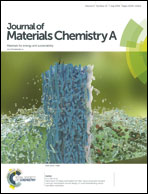Thermal convection induced TiO2 microclews as superior electrode materials for lithium-ion batteries†
Abstract
One great challenge of lithium-ion battery (LIB) commercialization is to achieve high rate capacity at large mass loading density. Here, a thermal-convection hydrothermal method was newly designed and developed to synthesize TiO2 microclews (TiO2 MCs) for their use as LIB electrode materials. The unique MC architecture could be immobilized on a carbon cloth collector uniformly to form a 3D flexible conductive network (TiO2 MCs@CC), which facilitates fast Li-ion and electron transport and promotes continuous lithiation reaction during the charge–discharge process. With these merits, TiO2 MCs@CC with high loading density (up to 4 mg cm−2) exhibits ultra-high rate performance (75 mA h g−1 at an extremely high current density of 4000 mA g−1), outstanding long-cycling life (74 mA h g−1 over 1000 cycles at a specific current density of 2000 mA g−1) and a high initial coulombic efficiency (ICE) of 82%. The demonstrated advantages open up possibilities for fabricating ultrafast rechargeable LIBs with potential industrial applications.



 Please wait while we load your content...
Please wait while we load your content...